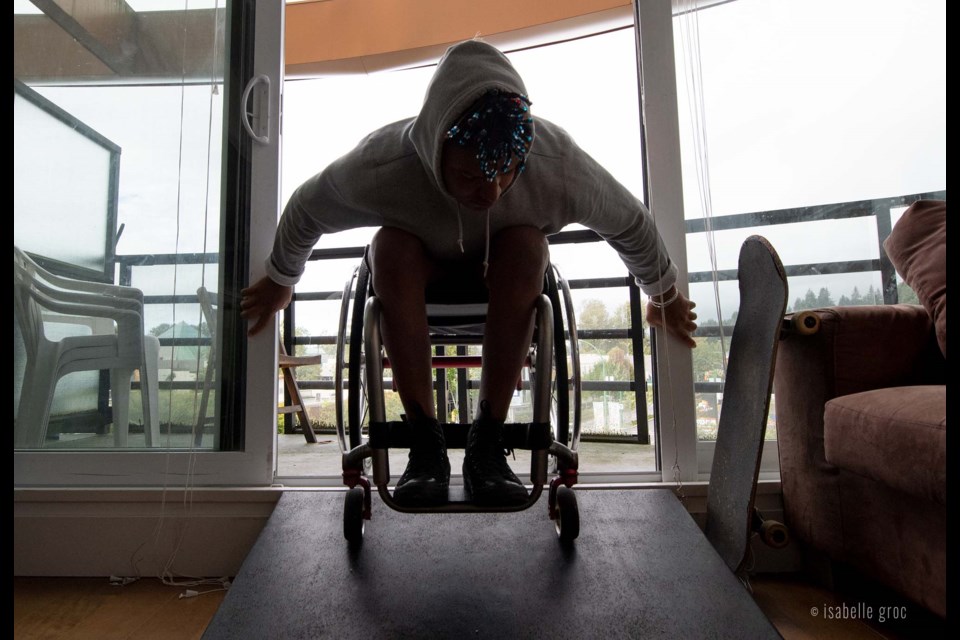Wheelchair user Terry Bowler says he changed his mind about applying for Canada’s “” (MAiD) process after finding a home he felt safe and secure in with support from . Instead, he's now waiting for a lung transplant.
The Right Fit, led by Disability Alliance BC (DABC), is a program that connects full-time wheelchair users with accessible housing in the Lower Mainland.
“It’s for any type of disability that uses a wheelchair full-time,” said DABC executive director Helaine Boyd.
Partnered with the Individualized Funding Resource Centre (IFRC), DABC manages the accessible unit supply side while the IFRC provides navigators who work directly with clients to match them with appropriate housing.
“They're the best place for that because they are mostly wheelchair users themselves,” said Boyd.
Unique program bridges housing supply and demand for wheelchair users
“We facilitate every aspect of their transition into their accessible homes, including access to home supports and assistive technology," said Right Fit program manager Isabelle Groc.
What makes the Right Fit unique is that it’s the only program in Canada that works within the intersection of supply and demand for wheelchair users.
Started as a pilot program in 2017, Boyd said The Right Fit developed after hearing from people and the community about how “daunting” it was to find accessible housing.
Landlords can be impatient about finding a renter and will move on quickly, Boyd said.
Having navigators to facilitate is what makes this program a success, giving a layer of trust and reassurance to both parties.
The general public may not understand how precarious the conditions are when wheelchair users live in inaccessible homes.
'if you’re not able to access parts of your home' it's a form of homelessness
Right Fit program manager Isabelle Groc likens being a wheelchair user who can't access part of their home to being homeless.
“So often people think about ‘homeless’ as being in shelters or on the street. But if you’re not able to access parts of your home and you’re not able to meet your basic needs, that is defined as ‘homelessness.’”
Wheelchair users can be the “invisible homeless” because they live in absolutely unacceptable conditions, said Groc.
Housing providers and policy-makers are often surprised by the stories Groc and her team share about wheelchair users who haven’t taken a bath or shower in years because they don’t have an accessible bathroom or who are confined to their bedroom because there’s no room to navigate a wheelchair or the home has stairs.
“They have to rely 100 per cent on other people.”
Without an accessible kitchen, Groc added, wheelchair users can’t cook proper meals and depend more on ready-made foods.
With the progression of his chronic obstructive pulmonary disease (COPD), Bowler went from a part-time walker user to a full-time wheelchair user and his previous home was too small to navigate.
If he wanted to cook, he had to do so with his wheelchair sideways to the sink and stove, twisting his back, sides, and shoulders.
The former truck driver commutes mainly by SkyTrain and HandyDart.
Bowler’s main priority in a home was proximity to a SkyTrain station. Since he became a wheelchair user, he has never used the bus.
“I’m too scared to go on," he admitted.
Bowler learned of the Right Fit program thanks to a pamphlet a hospital social worker gave him.
The main support he received was help with the paperwork and encouragement.
The staff treated him with respect and listened to him as an equal, Bowler attested, even when he rejected a potential home.
Program builds community among wheelchair users
It took him a year and a half to find his new home, which is three minutes from a SkyTrain station and in a building with neighbours who are also wheelchair users.
Bowler said he made new friends (also wheelchair users) while sitting in the waiting room for his The Right Fit appointments.
The program connected him to a community when, previously, the widower was overwhelmed and felt every day was too much of a struggle for a lone disabled person.
He’s lived in his new home for six months now and he has a different, happier outlook on life.
"The reality is that we’re constantly placing people but our wait list is constantly growing," said Groc.
Program in high demand in British Columbia
She currently has around 140 clients. Some clients prioritize having enough space for aides or caregivers and some prefer a roll-in shower.
A Victoria expansion is in the works, but the goal is to have it across B.C. due to the frequent requests they receive from all over the province, added Boyd.
As of March 31, 2024, BC Housing has funded 2,871 wheelchair-accessible units.
Their housing registry shows just under 5,000 households containing one or more people with disabilities and roughly one-fifth of those households require wheelchair accessible units.
BC Housing requires all new accessible units to meet the at the minimum. Furthermore, at least five percent of units in new projects have to be accessible.
BC Housing said many newer projects also feature units designed for future modifications for accessibility so residents have the opportunity to age in place.
As of May 2024, funded by BC Housing, The Right Fit program also has five rent supplements to give away to those who need wheelchair-accessible homes and independent living services.
Note: A previous version of this article had an incorrect figure for the program's rent supplements.



